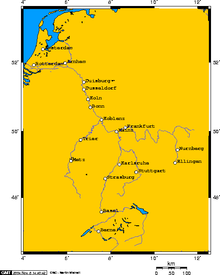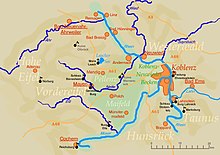| Revision as of 17:35, 5 June 2005 editHalibutt (talk | contribs)Autopatrolled, Extended confirmed users, Pending changes reviewers34,067 edits rv in accordance with the Talk:Gdansk/Vote (''Reverts to confirm with community consensus are excluded from the 3RR rule'')← Previous edit | Revision as of 17:37, 5 June 2005 edit undoMackensen (talk | contribs)Autopatrolled, Administrators125,162 editsm Reverted edits by Halibutt to last version by Eugene van der PijllNext edit → | ||
| Line 1: | Line 1: | ||
| {{dablink|For other places with the same name, see ] and ]}} | {{dablink|For other places with the same name, see ] and ]}} | ||
| '''Koblenz''' (also ''Coblenz'' |
'''Koblenz''' (also ''Coblenz'' and the French ''Coblence'') is after ] and ] the third largest city in ] (german ]), ]. It derives from the ancient Latin name ''Confluentes'' ("confluence" of river rhine and river mosel). | ||
| ] | ] | ||
Revision as of 17:37, 5 June 2005
For other places with the same name, see Koblenz, Switzerland and Koblenz (disambiguation)Koblenz (also Coblenz and the French Coblence) is after Mainz and Ludwigshafen am Rhein the third largest city in Rhineland-Palatinate (german Rheinland-Pfalz), Germany. It derives from the ancient Latin name Confluentes ("confluence" of river rhine and river mosel).

Koblenz lies in the Rhineland, 92 kilometers (57 miles) southeast of Cologne by rail, pleasantly situated on the left bank of the Rhine at its confluence with the Moselle. Population: (1885) 31,669; (1905) 53,902; (2002) 107,434.

Its defensive works are extensive, and consist of strong forts crowning the hills encircling the town on the west, and of the citadel of Ehrenbreitstein on the opposite bank of the Rhine. The old city was triangular in shape, two sides being bounded by the Rhine and Mosel and the third by a line of fortifications. The last were razed in 1890, and the town was permitted to expand in this direction. Immediately outside the former walls lies the new central railway station, in which is effected a junction of the Cologne-Mainz railway with the strategical line Metz-Berlin. The Rhine is crossed by a road bridge and, a mile above the town, by a beautiful bridge of two wide and lofty spans carrying the Berlin railway referred to above. The Moselle is spanned by a Gothic freestone bridge of 14 arches, erected in 1344, and also by a railway bridge.
The city, down to 1890, consisted of the Altstadt (old city) and the Neustadt (new city) or Klemenstadt. Of these, the Altstadt is closely built and has only a few fine streets and squares, while the Neustadt possesses numerous broad streets and a handsome frontage to the Rhine. In the more ancient part of Koblenz stand several buildings which have an historical interest. Prominent among these, near the point of confluence of the rivers, is the church of Saint Castor, with four towers. The church was originally founded in 836 by Louis the Pious, but the present Romanesque building was completed in 1208, the Gothic vaulted roof dating from 1498. In front of the church of Saint Castor stands a fountain, erected by the French in 1812, with an inscription to commemorate Napoleon's invasion of Russia. Not long after, Russian troops occupied Koblenz; and St Priest, their commander, added in irony these words: "Vu et approuvé par nous, Commandant russe de la Ville de Coblence: Janvier 1er, 1814."
In this quarter of the town, too, is the Liebfrauenkirche, a fine church (nave 1250, choir 1404--1431) with lofty late Romanesque towers; the castle of the electors of Trier, erected in 1280, which now contains the municipal picture gallery; and the family house of the Metternichs, where Prince Metternich, the Austrian statesman, was born in 1773.


In the modern part of the town lies the palace (Residenzschloss), with one front looking towards the Rhine, the other into the Neustadt. It was built in 1778-1786 by Clement Wenceslaus, the last elector of Trier, and contains among other curiosities some fine Gobelin tapestries. From it some pretty gardens and promenades (Kaiserin Augusta Anlagen) stretch along the bank of the Rhine, and in them is a memorial to the poet Max von Schenkendorf. A fine statue to the empress Augusta, whose favourite residence was Coblenz, stands in the Luisenplatz. But of all public memorials the most striking is the colossal equestrian statue of the emperor Wilhelm I of Germany, erected by the Rhine provinces in 1897, standing on a lofty and massive pedestal, at the point where the Rhine and Mosel meet.
Koblenz has also handsome law courts, government buildings, a theatre, a museum of antiquities, a conservatory of music, schools, five hospitals and numerous charitable institutions. Koblenz is a principal seat of the Mosel and Rhenish wine trade, and also does a large business in the export of mineral waters. Its manufactures include automotive parts (braking systems - TRW, gas springs and hydraulic vibration dampers - Stabilus), aluminium coils (Corus), pianos, paper, cardboard, machinery, boats and barges. It is an important transit centre for the Rhine railways and for the Rhine navigation.

History of Koblenz
Koblenz (Confluentes, Covelenz, Cobelenz) was one of the military posts established by Drusus about 9 B.C. Later it was frequently the residence of the Frankish kings, and in 860 and 922 was the scene of ecclesiastical synods. At the former of these, held in the Liebfrauenkirche, took place the reconciliation of Louis the German with his half-brother Charles the Bald.

In 1018 the city, after receiving a charter, was given by the emperor Henry II. to the archbishop of Trier (Treves), and it remained in the possession of the archbishop-electors till the close of the 18th century. In 1249-1254 it was surrounded with new walls by Archbishop Arnold II (of Isenburg); and it was partly to overawe the turbulent townsmen that successive archbishops built and strengthened the fortress of Ehrenbreitstein that dominates the city. As a member of the league of the Rhenish cities which took its rise in the 13th century, Koblenz attained to great prosperity; and it continued to advance till the disasters of the Thirty Years' War occasioned a rapid decline. After Philip Christopher, elector of Trier, had surrendered Ehrenbreitstein to the French the town received an imperial garrison (1632), which was soon, however, expelled by the Swedes. They in their turn handed the city over to the French, but the imperial forces succeeded in retaking it by storm (1636).
In 1688 Koblenz was besieged by the French under Marshal de Boufflers, but they only succeeded in bombarding the Altstadt into ruins, destroying among other buildings the old merchants' hail (Kaufhaus), which was restored in its present form in 1725. In 1786 the elector of Trier, Clement Wenceslaus of Saxony, took up his residence in the town, and gave great assistance in its extension and improvement; a few years later it became, through the invitation of his minister, Ferdinand, Freiherr von Duminique, one of the principal rendezvous of the French émigrés. This drew down upon the archbishop-elector the wrath of the French republicans; in 1794 Coblenz was taken by the French Revolutionary army under Marceau (who fell during the siege), and, after the signing of the Treaty of Lunéville (1801) it was made the chief town of the Rhine and Mosel department. In 1814 it was occupied by the Russians, by the congress of Vienna it was assigned to Prussia, and in 1822 it was made the seat of government of the Prussian Rhine province.
Source: ![]() This article incorporates text from a publication now in the public domain: Chisholm, Hugh, ed. (1911). Encyclopædia Britannica (11th ed.). Cambridge University Press.
This article incorporates text from a publication now in the public domain: Chisholm, Hugh, ed. (1911). Encyclopædia Britannica (11th ed.). Cambridge University Press. {{cite encyclopedia}}: Missing or empty |title= (help)
near Coblence the Lahneck Castel near Lahnstein on the picturesque Middel Rhein. Open to visitors from April 1st to October 3tst.
External links
- http://www.koblenz.de (English)
- Koblenz City Panoramas - Panoramic Views and virtual Tours
- Official Town Map of Koblenz. (needs Java and JavaSricpt)